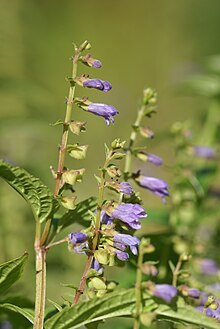Scutellaria lateriflora
| Scutellaria lateriflora | |
|---|---|
 |
|
| Scientific classification | |
| Kingdom: | Plantae |
| (unranked): | Angiosperms |
| (unranked): | Eudicots |
| (unranked): | Asterids |
| Order: | Lamiales |
| Family: | Lamiaceae |
| Genus: | Scutellaria |
| Species: | S. lateriflora |
| Binomial name | |
|
Scutellaria lateriflora L. |
|
Scutellaria lateriflora, known commonly as blue skullcap, mad dog skullcap, and side-flowering skullcap, is a hardy perennial herb of the mint family, Lamiaceae, native to North America.
It has an upright habit, growing 60 to 80 centimeters in maximum height. It is a wetland-loving species and grows near marshes, meadows, and other wet habitat. The blue flowers are just under a centimeter long. Most of the flowers do not appear at the top of the main stem, but are produced along the length of side branches that grow from the leaf axils.
Scutellaria lateriflora is used in herbal medicine as a mild sedative and sleep promoter. Other skullcaps used for similar purposes include common skullcap (S. galericulata), western skullcap (S. canescens), and southern skullcap (S. cordifolia). In a small-scale double blind, placebo-controlled study, blue skullcap had anxiety-reducing effects in 19 volunteers. S. lateriflora, along with reducing anxiety, significantly enhanced global mood without a reduction in energy or cognition.
β-Elemene in the herb had potential anti-cancer properties in vitro, but studies in humans have not confirmed its effectiveness.Diterpenes isolated from S. barbata had cytotoxic activity against three human cancer cell lines in vitro.
The principal phenolics in the leaves, stems, and roots of some Scutellaria species are baicalin, baicalein, wogonin, and oroxylin A. Baicalin has anti-inflammatory and analgesic effects in a rat model of thermal hyperalgesia. Another study identifies 5,6,7-trihydroxy-2'- methoxyflavone and its 7-O-glucuronide. A number of the flavones found in S. lateriflora have been reported to selectively bind with high affinity to central benzodiazepine receptor sites, leading to the view that the flavones exert anxiolytic and other benzodiazepine effects in rats.
...
Wikipedia

